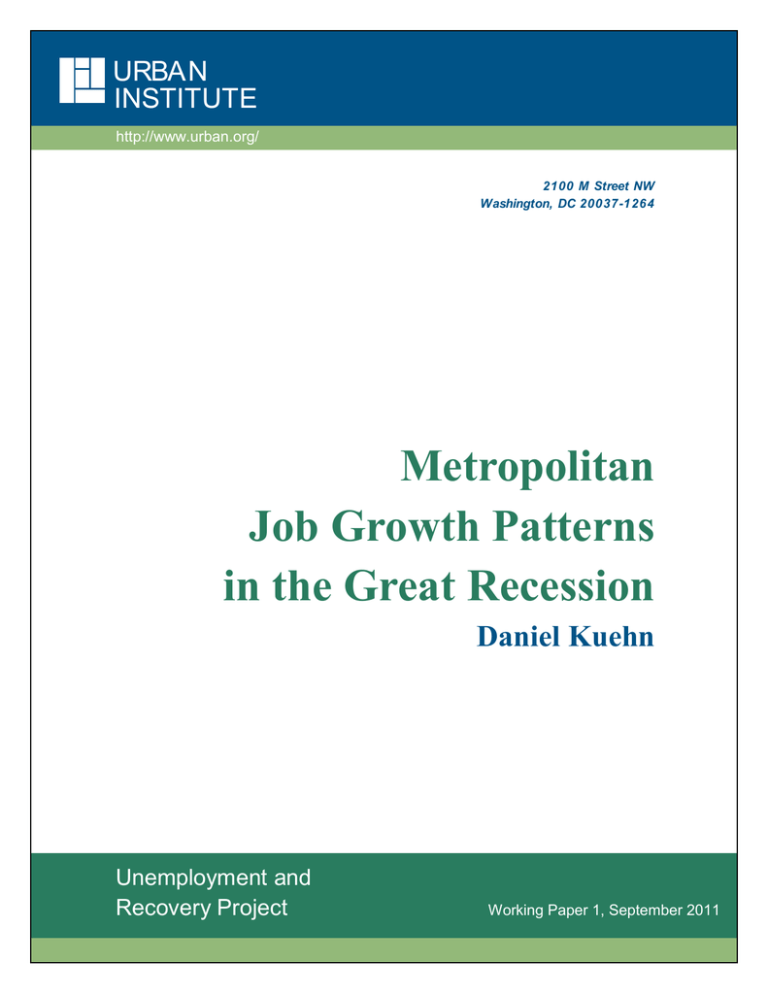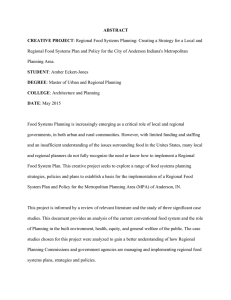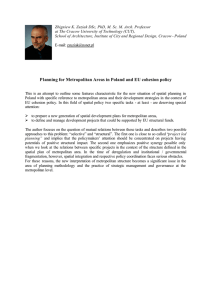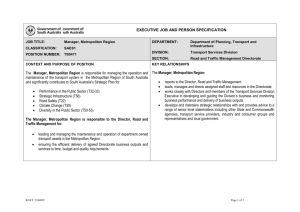Metropolitan Job Growth Patterns in the Great Recession Daniel Kuehn
advertisement

INSTITUTE URBAN http://www.urban.org/ INSTITUTE http://www.urban.org/ 2100 M Street NW Washington, DC 20037-1264 Metropolitan Job Growth Patterns in the Great Recession Daniel Kuehn Unemployment and Recovery Project Working Paper 1, September 2011 URBAN INSTITUTE Unemployment and Recovery Project This w orking paper is part of the Unemployment and Recovery project, an Urban Institute initiative to assess unemployment’ s effect on individuals, families, and communities; gauge government policies’ effectiveness; and recommend policy changes to boost job creation, improve w orkers’ job p rospects, and support out -of-w ork Americans. Copyright © September 2011 The view s expressed are those of the author and do not necessarily reflect those of the Urban Inst itute, its trustees, or its funders. Permission is granted for reproduction of this document, w ith attribution to the Urban Institute. URBAN INSTITUTE Metropolitan Job Growth Patterns in the Great Recession Daniel Kuehn The pace of job growth nationally in this recovery has been slow but not uniform across the country. Metropolitan areas have fared differently, with some experiencing substantially lower job loss than others. Although improving job growth is of paramount importance, we are also concerned with the quality of jobs that are created and lost and how this varies across metro areas. By examining employment changes across industries that pay higher and lower wages on average, we can identify metro areas that are faring better not only in total employment but in middle- or higher-wage jobs. This research brief uses data from the Bureau of Labor Statistics Quarterly Workforce Indicators (QWI) to examine job growth in high-, medium-, and low-paying industries across metropolitan areas during the Great Recession and the early period of economic recovery. Trends in Middle-Skill Jobs One reason to examine changes in different types of jobs is that some economists have proposed a ―polarization hypothesis‖ of broad trends in the skill level of jobs generated by the U.S. labor market over the last three decades.1 This interpretation of the data suggests that jobs requiring both high and low skill levels have enjoyed robust growth, but that middle-skill job growth has stagnated. However, others note that the polarization hypothesis is highly sensitive to how ―middle-skill‖ jobs are defined and that jobs requiring some postsecondary education short of a bachelor’s degree exhibit strong growth through the mid-2000s.2 One study found that rates of job growth for low-, medium-, and highwage jobs varied considerably across metropolitan areas during the 1990s—in large cities, job growth tended to be stronger but more polarized (higher growth in low- and highwage jobs), while medium-sized cities had weaker but also less polarized job growth.3 These studies were prior to the recession. We find that net job loss has been greatest in low- and high-wage industries, on average, with middle-wage industries faring the best, although this varies by metropolitan area. The low-, middle-, and high-wage industry categorization used here is a convenient way to measure differences in employment growth by types of jobs across metro areas. It is not necessarily the same as a categorization by skill or wage level, since each industry Unemployment and Recovery Project URBAN INSTITUTE includes a variety of jobs and we are focusing on the average. However, the performance of middle-wage industry jobs is an important consideration for policymakers concerned about the labor market performance of middle-class families and low-income working families aspiring to the middle class. Metropolitan Job Losses by Industry Group The Census Bureau partners with almost all state labor market information agencies to produce quarterly workforce indicators (QWIs) that provide detailed information on jobs, job creation and destruction, and turnover by industry. Industries can be categorized into three groups: industries with high, medium, and low average wages.4 During the Great Recession and the recovery so far, each industry group has exhibited quite different job growth. The recession lasted from the fourth quarter of 2007 to the second quarter of 2009. Over this period, net job growth in low wage industries in metropolitan America was -7.6 percent (see figure 1). Job growth was even weaker in high-wage industries at -8.6 percent. Relative to high- and low-wage industries, medium-wage industries did not fare as poorly during the recession. While the number of jobs in medium-wage industries in metropolitan areas did decline, it was only by 0.4 percent. Insofar as any polarization of the labor market has occurred over the last three decades, it has been partially offset by job trends during the recession, with losses concentrated in industries that typically pay high wages and low wages. Figure 1. Metropolitan Net Job Growth in Recession and Recovery (percent) Net job growth Net job during growth recession during (Q4, recovery 2007–Q2, (Q2, 2009–Q1, 2009) 2010) Low-wage industries Medium-wage industries High-wage industries Low-wage industries -7.6 -2.9 Medium-wage industries -0.4 -2.3 -0.4 -2.3 High-wage industries -2.9 -8.6 -5.2 -5.2 -7.6 -8.6 Net job growth during recession (Q4, 2007–Q2, 2009) Net job growth during recovery (Q2, 2009–Q1, 2010) Source: Author’ s calculations from Bureau of Labor Statistics Quarterly Workforce Indicators. Notes: Net job grow th is for metropolitan areas nationally, w eighted by metropolitan area population. Percent change in jobs for the recovery period is reported relative to job levels in the fourth quarter of 2007 so that pe rcentages are comparable betw een the recession and the recovery. Industry categories are defi ned by including roughly a third of all employment in each group: Low-wage industries: agriculture, fishing, and hunting; retail trade; administrative support and w aste management; arts, entertainment, and recreation; accommodation and food services; and other services. Medium-wage industries: w holesale trade; finance and insurance; real estate; education; and health care. High-wage industries: oil and gas extraction; utilities; construction; manufacturing; transportation and w arehousing; information; professional, scientific, and technical services; and management of companies and enterprises. 2 Unemployment and Recovery Project The economic recovery began after the second quarter of 2009, although many economic indicators suggest that it has been unusually weak. Metropolitan job growth is no exception to this trend, with continued net job losses in low-, medium-, and high-wage industries between the second quarter of 2009 and the first quarter of 2010. However, job loss during the recovery was more balanced across industry groupings than during the Great Recession, with a 2.9 percent decline in low-wage, 2.3 percent decline in mediumwage, and 5.2 percent decline in high-wage industries. While job loss was somewhat lower in high- and low-wage industries during the recovery, middle-wage industries actually showed more weakness than they did during the initial downturn. Variability across Metropolitan Areas Tables 1 and 2 present job growth during the Great Recession (Q4, 2007 to Q2, 2009) and the recovery (Q2, 2009 to Q1, 2010) for 86 of the largest metropolitan areas in the U.S.5 While some localities experience net job growth (particularly in medium-wage industries) and there is substantial variation between metropolitan areas, the general pattern of net job growth nationally is also apparent in most cases at the metropolitan level: lowand high-wage industries experience substantial net job losses during the recession while job losses in medium-wage industries are more modest, and job loss during the recovery is lower and more balanced across industry groups. These tables present job growth as a percent of total jobs in the fourth quarter of 2007, so it is possible that a metropolitan area or industry group experiencing a higher rate of job loss may have lost a lower absolute number of jobs. Net job losses in low- and high-wage industries were disproportionately concentrated in metropolitan areas in California. While about 1 in 7 of the largest metropolitan areas considered here are located in California, Californian metropolitan areas are four of the top ten losers of low-wage industry jobs (Bakersfield, Fresno, Stockton, and San Jose–Sunnyvale–Santa Clara) and four of the top ten losers of high-wage industry jobs (Modesto, Riverside–San Bernardino–Ontario, Santa Rosa–Petaluma, and Stockton) during the recession. Metropolitan Areas with Better Than Average Job Growth Despite the substantial net job losses during the Great Recession and weak labor market during the recovery, some metropolitan areas have performed better than others and have even added jobs on net in certain sectors. One way to identify high-performing labor markets and identify the industries that underlie their relative success is to highlight metropolitan areas with higher-than-average job growth in both the recession (Q4, 2007 to 3 URBAN INSTITUTE Table 1. Percentage Change in Jobs from Q4, 2007 to Q2, 2009 Low -Wage In- Medium-Wage Metropolitan Area dustries Industries National Average (all metropolitan areas) -7.61 -0.41 -8.60 Akron, OH -9.00 2.72 -6.73 Albany-Schenectady-Troy, NY -7.12 -0.08 -2.36 Albuquerque, NM -8.15 15.01 -11.89 Allentow n-Bethlehem-Easton, PA-NJ -9.46 1.75 -7.37 Atlanta-Sandy Springs-Marietta, GA -9.66 -2.99 -5.70 Augusta-Richmond County, GA -SC -5.49 -3.16 -7.78 Austin-Round Rock, TX -2.21 5.04 -6.54 Bakersfield, CA -19.80 0.55 -4.43 Baltimore-Tow son, MD -7.95 1.58 -3.35 Birmingham-Hoover, AL -8.63 -3.17 -9.09 Boise City-Nampa, ID -9.01 -0.49 -17.58 Bridgeport -Stamford-Norw alk, CT -11.29 -3.32 -7.74 Buffalo-Niagara Falls, NY -8.00 -2.02 -4.37 Charleston-North Charleston-Summerville, SC -8.82 -3.08 -8.51 Charlotte-Gastonia-Concord, NC-SC -8.31 -4.76 -10.23 Chattanooga, TN-GA -7.38 3.34 -15.89 Chicago-Naperville-Joliet, IL-IN-WI -8.42 -0.90 -9.26 Cincinnati-Middletow n, OH-KY-IN -10.02 -0.95 -7.29 Cleveland-Elyria-Mentor, OH -10.03 -11.59 -10.97 Colorado Springs, CO -8.57 0.46 -9.49 Columbia, SC -7.40 -0.38 -6.85 Columbus, OH -6.12 2.75 -7.58 Dallas-Fort Worth-Arlington, TX -3.83 0.87 -5.79 Dayton, OH -10.12 -0.90 -12.08 Denver-Aurora-Broomfield, CO -9.02 -6.82 -1.64 Des Moines-West Des Moines, IA -3.14 1.27 -7.49 -10.42 -1.70 -17.22 Detroit-Warren-Livonia, MI El Paso, TX 0.68 1.75 -1.42 Fresno, CA -13.57 -0.54 -11.14 Grand Rapids-Wyoming, MI -11.06 -6.55 -13.26 Greensboro-High Point, NC -11.22 -0.63 -10.10 Greenville-Mauldin-Easley, SC -8.15 -0.38 -9.96 Harrisburg-Carlisle, PA -4.32 -1.21 -6.49 Hartford-West Hartford-East Hartford, CT -7.63 0.61 -7.44 Honolulu, HI -5.17 -1.79 -9.66 Houston-Sugar Land-Baytow n, TX -1.92 0.48 -2.39 Indianapolis-Carmel, IN 4 High-Wage Industries -11.32 3.34 -10.21 Jackson, MS -7.23 11.63 -7.29 Kansas City, MO-KS -7.78 1.64 -7.77 Knoxville, TN -7.99 12.10 -12.60 Lancaster, PA -8.30 3.33 -9.70 Lansing-East Lansing, MI -8.76 -0.48 -8.49 Unemployment and Recovery Project Table 1, continued: Percentage Change in Jobs from Q4, 2007 to Q2, 2009 Low -Wage Medium-Wage InMetropolitan Area Industries dustries High-Wage Industries Las Vegas-Paradise, NV -9.95 -4.88 -16.54 Little Rock-North Little Rock-Conw ay, AR -4.49 4.78 -5.61 Los Angeles-Long Beach-Santa Ana, CA -9.46 -2.36 -8.39 Louisville-Jefferson County, KY-IN -7.71 -0.53 -8.31 Madison, WI -7.24 2.08 -6.79 McAllen-Edinburg-Mission, TX 2.50 4.12 -5.83 Memphis, TN-MS-AR -9.67 -0.89 -5.81 Milw aukee-Waukesha-West Allis, WI -9.31 1.43 -8.67 Minneapolis-St. Paul-Bloomington, MN-WI -11.54 0.74 -5.85 Modesto, CA -10.32 0.34 -17.43 Nashville-Davidson-Murfreesboro-Franklin, TN -10.35 2.01 -9.36 New Haven-Milford, CT -8.17 0.14 -8.95 New York-Northern New Jersey-Long Island, NY-NJ-PA -5.77 -2.60 -6.13 Omaha-Council Bluffs, NE-IA -5.82 1.86 -4.72 Oxnard-Thousand Oaks-Ventura, CA -2.92 1.52 -13.22 Philadelphia-Camden-Wilmington, PA-NJ-DE-MD -6.92 1.01 -6.30 Phoenix-Mesa-Scottsdale, AZ -9.63 -1.04 -18.07 Pittsburgh, PA -5.60 -0.64 -4.68 Portland-South Portland-Biddeford, ME -11.96 1.25 -6.91 Portland-Vancouver-Beaverton, OR-WA -10.80 0.23 -10.68 Poughkeepsie-New burgh-Middletow n, NY -8.92 3.49 -12.93 Providence-New Bedford-Fall River, RI-MA -10.30 -0.54 -13.34 Raleigh-Cary, NC -5.15 -3.71 16.68 Richmond, VA -2.44 -3.37 -8.79 Riverside-San Bernardino-Ontario, CA -5.71 -1.79 -16.37 Rochester, NY -8.84 3.13 -9.15 Sacramento-Arden-Arcade-Roseville, CA -6.25 -2.43 -7.31 Salt Lake City, UT -4.33 -4.09 -9.36 San Antonio, TX -2.08 2.73 -3.45 San Diego-Carlsbad-San Marcos, CA -9.75 0.78 -8.73 San Francisco-Oakland-Fremont, CA -7.37 -1.66 -8.18 San Jose-Sunnyvale-Santa Clara, CA -11.07 -3.17 -8.32 Santa Rosa-Petaluma, CA -9.18 -2.82 -15.59 Scranton-Wilkes-Barre, PA -8.20 -1.23 -6.68 Seattle-Tacoma-Bellevue, WA -7.19 0.97 -7.41 St. Louis, MO-IL -5.39 -0.07 -8.38 Stockton, CA -12.47 0.21 -13.97 Syracuse, NY -9.85 0.46 -6.48 Toledo, OH -9.84 0.08 -11.98 Tucson, AZ -9.31 -2.81 -3.04 Virginia Beach-Norfolk-New port New s, VA-NC -4.13 -0.41 -9.37 Washington-Arlington-Alexandria, DC-VA-MD-WV -5.69 -1.92 -5.79 Wichita, KS -1.40 1.41 Youngstow n-Warren-Boardman, OH-PA -9.18 -1.26 Source: Author’ s calculations from the Bureau of Labor Statistics Quarterly Workforce Indicators. -4.06 -18.72 5 URBAN INSTITUTE Table 2: Percentage Change in Jobs from Q2, 2009 to Q1, 2010 Low -Wage Medium-Wage Metropolitan Areas Industries Industries 6 High-Wage Industries National Average (all metropolitan areas) -2.92 -2.29 -5.17 Akron, OH -0.09 2.15 -6.16 Albany-Schenectady-Troy, NY -2.77 -3.14 -4.56 Albuquerque, NM -3.08 -4.13 -7.50 Allentow n-Bethlehem-Easton, PA-NJ 1.45 0.25 -7.31 Atlanta-Sandy Springs-Marietta, GA -4.28 -0.46 -7.02 Augusta-Richmond County, GA -SC -1.71 -1.91 -2.44 Austin-Round Rock, TX -3.09 1.95 -3.57 Bakersfield, CA -1.52 -4.66 -6.00 Baltimore-Tow son, MD -2.95 -3.83 -5.48 Birmingham-Hoover, AL -2.96 -2.86 -4.82 Boise City-Nampa, ID -5.50 -2.05 -5.19 Bridgeport -Stamford-Norw alk, CT -2.06 -3.46 -5.28 Buffalo-Niagara Falls, NY -2.48 -2.97 -3.95 Charleston-North Charleston-Summerville, SC -5.80 -1.24 -6.89 Charlotte-Gastonia-Concord, NC-SC -2.74 -7.25 -5.60 Chattanooga, TN-GA -3.50 -1.90 -1.15 Chicago-Naperville-Joliet, IL-IN-WI -3.19 -2.80 -5.96 Cincinnati-Middletow n, OH-KY-IN -2.72 -3.38 -5.25 Cleveland-Elyria-Mentor, OH -3.99 9.56 -5.33 Colorado Springs, CO 0.65 1.25 -10.32 Columbia, SC -1.89 -2.14 -5.02 Columbus, OH -4.97 -4.15 -3.00 Dallas-Fort Worth-Arlington, TX -3.05 -1.74 -5.65 Dayton, OH -3.09 -7.27 -5.15 Denver-Aurora-Broomfield, CO -5.56 4.76 -7.61 Des Moines-West Des Moines, IA -4.62 0.49 -5.84 Detroit-Warren-Livonia, MI -5.69 -2.09 -2.86 El Paso, TX 0.58 3.14 -3.13 Fresno, CA -4.75 -3.45 -6.27 Grand Rapids-Wyoming, MI -1.51 -4.82 -0.94 Greensboro-High Point, NC -4.07 -3.19 -6.50 Greenville-Mauldin-Easley, SC -2.40 -4.74 -4.60 Harrisburg-Carlisle, PA -2.86 -10.58 8.05 Hartford-West Hartford-East Hartford, CT -3.04 -5.22 -5.72 Honolulu, HI 0.13 -6.07 -1.98 Houston-Sugar Land-Baytow n, TX -3.60 0.89 -5.98 Indianapolis-Carmel, IN -3.21 -2.99 -3.76 Jackson, MS -2.96 -4.28 -4.70 Kansas City, MO-KS -2.91 -3.33 -7.62 Knoxville, TN -3.16 -2.37 -1.02 Lancaster, PA -0.81 -2.98 -3.70 Lansing-East Lansing, MI -3.65 -1.65 -7.55 Las Vegas-Paradise, NV -2.08 -3.59 -11.83 Unemployment and Recovery Project Table 2, continued: Percentage Change in Jobs from Q2, 2009 to Q1, 2010 Low -Wage Medium-Wage Metropolitan Areas Industries Industries High-Wage Industries Little Rock-North Little Rock-Conw ay, AR -1.07 -0.55 -6.78 Los Angeles-Long Beach-Santa Ana, CA -3.63 -4.65 -6.38 Louisville-Jefferson County, KY-IN -2.75 -0.41 -5.49 Madison, WI -0.99 -7.25 -3.91 McAllen-Edinburg-Mission, TX -5.70 1.90 -3.96 Memphis, TN-MS-AR -4.35 -0.87 -4.62 Milw aukee-Waukesha-West Allis, WI -0.64 -4.57 -6.93 Minneapolis-St. Paul-Bloomington, MN-WI -2.03 -3.07 -8.81 Modesto, CA -4.63 -3.61 -6.44 Nashville-Davidson-Murfreesboro-Franklin, TN -0.82 -1.31 -4.51 New Haven-Milford, CT -2.36 -3.38 -5.96 New York-Northern New Jersey-Long Island, NY-NJ-PA -0.73 -0.52 -3.56 Omaha-Council Bluffs, NE-IA -3.91 -1.33 -5.35 Oxnard-Thousand Oaks-Ventura, CA -9.18 -6.96 -8.93 Philadelphia-Camden-Wilmington, PA-NJ-DE-MD -1.91 -3.47 -5.74 Phoenix-Mesa-Scottsdale, AZ -3.05 -3.96 -6.57 Pittsburgh, PA -1.16 0.18 -3.95 Portland-South Portland-Biddeford, ME -1.31 -3.43 -3.59 Portland-Vancouver-Beaverton, OR-WA -2.94 -3.02 -5.56 Poughkeepsie-New burgh-Middletow n, NY 0.05 -0.91 -0.33 Providence-New Bedford-Fall River, RI-MA -2.66 -1.99 -5.09 Raleigh-Cary, NC -1.03 7.75 -4.57 Richmond, VA -5.09 -10.52 -6.07 Riverside-San Bernardino-Ontario, CA -3.64 -4.87 -5.81 Rochester, NY 0.09 -4.76 -2.76 Sacramento-Arden-Arcade-Roseville, CA -4.63 -5.25 -5.65 Salt Lake City, UT 1.23 3.46 -2.34 San Antonio, TX -4.17 -1.57 -4.53 San Diego-Carlsbad-San Marcos, CA -3.99 -3.71 -6.39 San Francisco-Oakland-Fremont, CA -2.52 -3.62 -6.08 San Jose-Sunnyvale-Santa Clara, CA -2.94 -2.86 -4.89 Santa Rosa-Petaluma, CA -2.81 -8.18 -8.13 Scranton-Wilkes-Barre, PA -3.17 0.38 -4.73 Seattle-Tacoma-Bellevue, WA -2.69 -4.29 -5.53 St. Louis, MO-IL -4.87 -4.65 -6.42 Stockton, CA -4.15 -6.49 -5.81 Syracuse, NY -0.68 -4.71 -3.74 Toledo, OH -4.68 -3.15 -8.51 Tucson, AZ -1.68 -13.07 -3.58 Virginia Beach-Norfolk-New port New s, VA-NC -4.79 -7.10 -0.25 Washington-Arlington-Alexandria, DC-VA-MD-WV -3.11 1.23 -1.93 Wichita, KS -4.33 -3.16 -10.78 Youngstow n-Warren-Boardman, OH-PA -1.32 -1.25 Source: Author’ s calculations from the Bureau of Labor Statistics Quarterly Workforce Indicators. -8.09 7 URBAN INSTITUTE Q2, 2009) and the recovery (Q2, 2009 to Q1, 2010). Box 1 presents metropolitan areas that had higher than average job growth in both of these phases of the recent business cycle for low-wage industries, and Boxes 2 and 3 present the metropolitan areas that achieve this distinction for medium- and high-wage industries, respectively. Since job losses were higher than job growth in all of these industry categories, nationally, many metropolitan areas with ―higher than average job growth‖ still had net job losses in the category—they merely lost a lower percentage of jobs on net than the national average. Box 1. Metropolitan Areas with Better Than Average Job Growth during the Recession and Early Recovery for Low-Wage Industries Albany-Schenectady-Troy, NY Augusta–Richmond County, GA -SC Columbia, SC El Paso, TX Honolulu, HI Little Rock–North Little Rock–Conw ay, AR Louisville–Jefferson County, KY-IN Madison, WI New York–Northern New Jersey–Long Island, NY-NJ-PA Philadelphia-Camden-Wilmington, PA-NJ-DE Pittsburgh, PA Raleigh-Cary, NC Salt Lake City, UT San Francisco–Oakland–Fremont, CA Seattle-Tacoma-Bellevue, WA Source: Author’ s calculations from the Bureau of Labor Statistics Quarterly Workforce Indicators . Metropolitan Areas with Better Than Average Growth in Low-Wage Industries Fifteen of the 86 metropolitan areas examined had greater than average job growth in low-wage industries during both the recession and the recovery, including large urban centers such as New York, Philadelphia, San Francisco, and Seattle. Among the six industries classified as low-wage industries, a plurality of jobs is concentrated in retail trade, with large shares of total jobs also in administrative support and waste management, and in accommodation and food services. For this reason, job performance in these three industries is an important determinant of job growth in low-wage industries overall. The retail trade and the administrative support and waste management industries were not a source of job growth, even for these labor markets which were relatively more successful than the rest of metropolitan America. During the Great Recession, retail jobs only increased in El Paso, Texas, and decreased everywhere else, while administrative support and waste management jobs declined in all cases. Many more metropolitan areas in this group saw slight job growth in these two industries during the recovery, although never more than 3.6 percent in the case of retail trade (achieved in Honolulu, Hawaii). Many of the low-wage jobs created in the metropolitan areas with better than average job growth were created in accommodation and food services. Markets like Augusta, Georgia; 8 Unemployment and Recovery Project Honolulu, Hawaii; and Raleigh, North Carolina added many jobs in this industry even in the midst of the Great Recession. Metropolitan Areas with Better Than Average Growth in Medium Wage Industries Medium-wage industries experienced surprisingly modest job losses during the Great Recession, relative to low- and high-wage industries, ameliorating concerns associated with the polarization hypothesis that midlevel job opportunities have become less available. Sixteen metropolitan areas had higher than average job growth in medium-wage industries during both the Great Recession and the early recovery. All six of the metropolitan areas located in Texas that were considered were members of this group and exceeded national performance levels. While net job growth in Texas has been robust, unemployment has not been substantially better than the national unemployment rate. The preliminary July 2011 unemployment rate for Texas was the 27th highest state unemployment rate out of 50 states and the District of Columbia (Bureau of Labor Statistics 2011). High job growth and unemployment suggests that the labor force in Texas is growing along with jobs, likely due to demographic trends. In addition to the six metropolitan areas in Texas, four other southern cities had better than average growth in middle-wage jobs. Growth in middle-wage industries for these 16 metropolitan areas and for metropolitan areas nationally was driven by job growth in education and health care, which was robust during both the Great Recession and the recovery. These growth industries, which have been referred to as ―eds and meds‖ and cited as an important source of urban development,6 experienced especially strong growth in the metropolitan areas presented in box 2. Educational job growth in metropolitan areas nationally was actually much weaker during the recovery period (-3.4 percent) than during the Great Recession itself (3.7 percent), reversing the pattern observed in most industries. Box 2. Metropolitan Areas with Better Than Average Job Growth During the Recession and Early Recovery for Medium-Wage Industries Akron, OH Allentow n-Bethlehem-Easton, PA-NJ Austin–Round Rock, TX Chattanooga, TN-GA Colorado Springs, CO Dallas–Fort Worth–Arlington, TX Des Moines–West Des Moines, IA El Paso, TX Houston–Sugar Land–Baytow n, TX Knoxville, TN Little Rock–North Little Rock–Conw ay, AR McAllen-Edinburg-Mission, TX Nashville-Davidson-Murfreesboro-Franklin, TN Omaha–Council Bluffs, NE-IA Poughkeepsie-New burgh-Middletow n, NY San Antonio, TX Source: Author’ s calculations from the Bureau of Labor Statistics Quarterly Workforce Indicators. 9 URBAN INSTITUTE Metropolitan Areas with Better Than Average Growth in High-Wage Industries High-wage industry employment in metropolitan America is dominated by three industrial sectors: construction, manufacturing, and professional, scientific, and technical services. Construction and manufacturing are classically cyclical industries, with large declines in business activity during recessions. Moreover, manufacturing employment levels have been undergoing a secular decline while construction jobs have been decimated by the housing crisis that sparked the Great Recession. Trends in these industries dominate the sharp drop in high-wage industry jobs during both the recession and the recovery. The metropolitan areas that outperformed others on job growth in high-wage industries during the bust and the boom were, in many cases, the labor markets that had stronger growth (or more modest losses) in these large and typically cyclical industries. For example, while net job growth in construction across the country during the Great Recession was down 23.1 percent, El Paso, Texas, only lost on net 3.1 percent of its construction jobs and San Antonio, Texas, lost only 5.9 percent. However, most of the metropolitan areas represented in box 3 still had poor construction job growth that was more comparable to metropolitan areas nationally. These labor markets outperformed others by adding jobs in other industries, such as professional, scientific, and technical services. While job growth in this industry for metropolitan areas nationally was -1.4 percent during the recession and -4.3 percent during the recovery, most of the labor markets in box 3 added professional, scientific, and technical service jobs during the recession. Metropolitan areas in Texas are well represented among the labor markets with better than average performance on high-wage industry job growth during the recession and the recovery. Also in this group are several ―rust belt‖ metropolitan areas with lower than average manufacturing job losses, including Albany, Buffalo, and Syracuse, New York; Harrisburg, Pittsburgh, and Scranton, Pennsylvania; and Columbus, Ohio. Box 3. Metropolitan Areas with Better Than Average Job Growth during the Recession and Early Recovery for High-Wage Industries Albany-Schenectady-Troy, NY August –Richmond County, GA -SC Austin–Round Rock, TX Buffalo–Niagara Falls, NY Columbia, SC Columbus, OH El Paso, TX Harrisburg-Carlisle, PA Jackson, MS Madison, WI McAllen-Edinburg-Mission, TX Memphis, TN-MS-AR New York–Northern New Jersey–Long Island, NY-NJ-PA Pittsburgh, PA Portland–South Portland–Biddeford, NE Raleigh-Cary, NC San Antonio, TX San Jose–Sunnyvale–Santa Clara, CA Scranton–Wilkes-Barre, PA Syracuse, NY Tuscon, AZ Washington-Arlington-Alexandria, DC-VA-MD-WV Source: Author’ s calculations from the Bureau of Labor Statistics Quarterly Workforce Indicators. 10 Unemployment and Recovery Project Conclusion The American labor market is extremely heterogeneous, with job growth varying substantially across low-, medium-, and high-wage industries, various skill groups, and metropolitan areas that are on different trajectories. Research on these differences has noted that while many middle-wage and middle-skill jobs are available, they are often inaccessible to workers with low education levels, and the availability of these jobs can be contingent on local labor market conditions. This research brief presents evidence on labor markets at the metropolitan-area level, and finds that job loss in medium-wage industries was much less severe during the Great Recession than job loss in low- and high-wage industries. Metropolitan areas in California do relatively poorly. Texas labor markets do well in all three industry groups, and many rust belt markets also have surprisingly resilient high-wage industries, relative to the rest of the country. While successful labor markets are represented here, the jobs picture for many metropolitan areas nationally is still bleak. Notes 1. See Autor (2010); Autor, Katz, and Kearney (2008); and Autor, Levy, and Murnane (2003). 2. See Holzer (2010). 3. See Holzer et al. (2011). 4. The industry categories are created by ranking industries by average wage and taking roughly one-third of employment in each group. The categories are Low-wage industries: agriculture, fishing, and hunting; retail trade; administrative support and waste management; arts, entertainment, and recreation; accommodation and food services; and other services. Medium-wage industries: wholesale trade; finance and insurance; real estate; education; and health care. High-wage industries: oil and gas extraction; utilities; construction; manufacturing; transportation and warehousing; information; professional, scientific, and technical services; and management of companies and enterprises. 5. The QWI data do not cover all states through the period of recovery from the Great Recession. Up-to-date quarterly workforce indicators are not available for metropolitan areas in the District of Columbia, Florida, Louisiana, Massachusetts, New Hampshire, and Oklahoma. The 86 metropolitan areas reviewed here are the subset of the 100 largest metropolitan areas nationwide that are included in the available data. 6. See Bartik and Erickcek (2008). References Autor, David. 2010. ―The Polarization of Job Opportunities in the U.S. Labor Market: Implications for Employment and Earnings.‖ Washington, DC: Center for American Progress and Hamilton Project. Autor, David, Lawrence Katz, and Melissa Kearney. 2008. ―Trends in U.S. Wage Inequality: Revising the Revisionists.‖ Review of Economics and Statistics 90(2): 300–323. Autor, David, Frank Levy, and Richard Murnane. 2003. ―The Skill Content of Recent Technological Change: An Empirical Exploration.‖ Quarterly Journal of Economics 118(4): 1279–1334. 11 URBAN INSTITUTE Bartik, Timothy, and George Erickcek. 2008. The Local Economic Impact of ―Eds & Meds‖: How Policies to Expand Universities and Hospitals Affect Metropolitan Economies. Washington, DC: The Brookings Institution. Bureau of Labor Statistics. 2011. Unemployment Rates for States. http://www.bls.gov/web/laus/laumstrk.htm. Accessed August 19, 2011. Holzer, Harry. 2010. Is the Middle of the U.S. Job Market Really Disappearing? Washington, DC: Center for American Progress. Holzer, Harry, Julia Lane, David Rosenblum, and Fredrik Andersson. 2011. Where Are All the Good Jobs Going? What National and Local Job Quality and Dynamics Mean for U.S. Workers. New York: Russell Sage Foundation. 12




